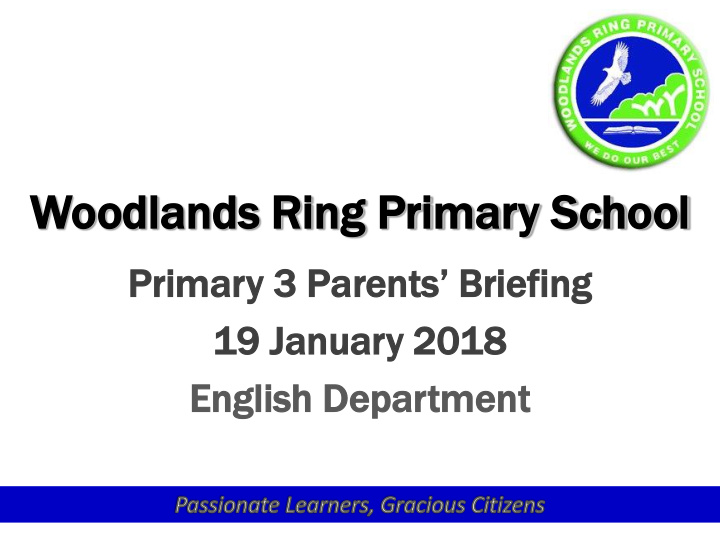



Wood odlands lands Ri Ring g Prim imar ary y Schoo hool Primary 3 Parents’ Briefing 19 Ja 19 Janu nuar ary y 20 2018 Eng nglish lish Depa partm tment ent
STEL TELLAR LAR @ P @ P3 P3 STELLAR Programme
STEL TELLAR LAR @ P @ P3 STELLAR Curriculum hopes to deliver children who • love reading and • have a strong foundation in the English Language
STELLAR (P3, Semester 1) Shared Book Process Writing Approach
Process Writing
Process Writing
Assessment for Learning (AfL) Grammar Vocabulary To develop pupils’ To facilitate pupils’ knowledge of and acquisition of a rich proficiency in grammar vocabulary
Semestral Assessment (SA) 1 & 2 Allocation of Marks English Paper 1 20 (Composition) English Paper 2 50 (Lang use & Compre) English Paper 3 14 (Listening Compre) English Paper 4 16 (Oral) Total 100 marks
Semestral Assessment Paper 2 / Language Use • – Vocabulary MCQ – Grammar MCQ/Cloze – Visual Text Comprehension – Synthesis & Transformation – Comprehension
Com ompre prehe hension nsion 1 1 & 2 • Up to 10 questions testing a variety of items (e.g. MCQ, sequencing, open-ended)
Comprehension 1 & 2
• Both Comprehension sections require: Good reading comprehension skills Strong vocabulary • Pupils need to: Read carefully Be alert to the clues/visuals in the passage and/or questions
Str Strat ateg egies ies for or Com ompre prehe hension nsion • Read the questions before the passage to get an idea of what to look out for later • Highlight the question word (e.g. why, what, etc.) in each question • Pay attention to the tense of the main verb in the question (for open-ended questions)
Stimulus-based Conversation • A merge of Picture Discussion and Conversation • Pupils will be given a picture (i.e. stimulus) during preparation time to analyse • Themes in the topics are broadly linked to those in the reading passage
Prompts: • Would you buy this product? Why or why not? • Do you like to eat snacks in between meals? Why or why not? • When you buy food products, do you pay attention to the food labels? Why or why not?
Stra St rategies egies for r St Stim imulu lus-Based ased Conver ersation sation • Answer in complete sentences • Provide examples to explain reasons • Use the 5Ws, 1H ( w ho, w hat, w here, w hen, w hy, h ow) to elaborate on examples • Try to think of / predict possible conversation topics in relation to the given picture and reading passage
Summary of Skills
Helping your child in this journey Encourage your child to: LISTEN to it! Inp nput READ it! SPEAK it! Ou Output put WRITE in it!
Helping your child in this journey • Make going to the library a habit • Set aside 30 minutes a day of family reading time • Let them listen to Standard English programmes • Encourage your child to speak English to his/her friends in school
Helping your child in this journey Ensure that your child: • completes his/her corrections and learns from the mistake/s made • studies for spelling/dictation • Encourage your child to read widely across different genres
Helping your child in this journey Check to see that he/she has used the strategies taught by the teacher: • highlighting key words underlining • • backward/forward referencing for cloze Encourage him/her to read aloud to you.
Helping your child in this journey ht http://www tp://www.s .stella ellarlit rliteracy eracy.sg/ .sg/
Recommend
More recommend